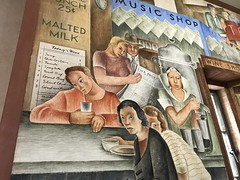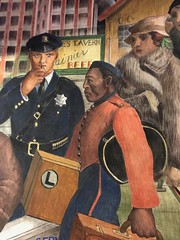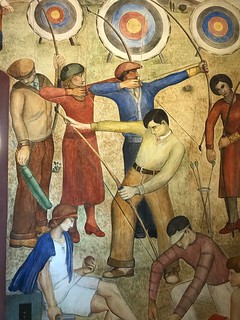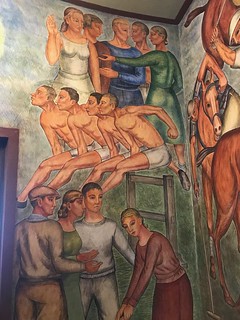
First floor murals
A couple years ago I visited the top of Coit Tower for the first time. In that blog post I noted:
I should point out there is a second activity at Coit Tower that isn’t as well advertised, and I have yet to try it myself: in addition to the Depression era murals in the lobby, there’s a small second floor above it with more murals.
On Saturday I finally went to tour the murals with the free City Guides Coit Tower Murals Tour. Here’s what I learned on the tour.
The lobby space was built without any particular purpose, but two local artists were able to secure funding from a New Deal program to hire muralists to paint the walls with frescoes. The left-leaning artists settled on the Social Realism style which was popular at the time, though not without some controversy.
As you can see from the photos at the top of this post, the themes of these murals focus on labor and daily life, as you’d expect for an art style closely associated with socialism.
Due to tourists slowly filling up the lobby (August is peak tourism season, after all) I wasn’t able to get as many photos as I would have liked. A particular mural depicts a scene at a library where most people are reading newspapers with headlines contemporary for the day, but is mostly known for prominently featuring a man in the front pulling a copy of Das Kapital off a library shelf. One group after another came in and snapped selfies of themselves in front of it.
It’s worth pointing out that the ethnicity of the people in the murals is skewed to the point of historical revisionism. The absence of Chinese Americans and Latin Americans is especially jarring.
What’s on the second floor?
Coit Tower’s second floor is densely covered in murals but was typically off limits to the public until their 2014 restoration. What’s up there? Let’s take a look.

After going through a “secret” door, a spiral staircase features murals on both walls depicting life along Powell Street. Although these murals are approaching 90 years old it’s amazing how little has changed, fashion choices aside. People are carrying suitcases and walking their dogs, and the cable cars and oversized fire hydrants look identical to what you’ll see today.
Here’s another view from the second floor down the spiral staircase:

Compared to the murals downstairs, this street life scene appears to represent a transition of sorts. Instead of farmers and factory workers we see mostly well-dressed and presumably wealthier people. The workers are few and far between, many of whom are police officers.
This transition becomes more obvious when exiting the staircase to the second floor landing.
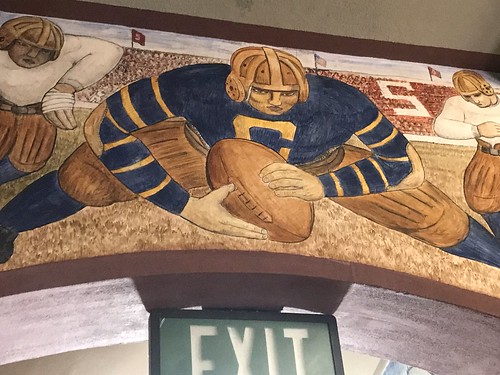
Just above the stairs is a small landing with a series of sports murals. At first it seems like it could be Olympic games, but if you turn around and look at the wall over the staircase, it’s clearly a Cal-Stanford football game. So I think it’s safe to assume this mural is about local college sports.
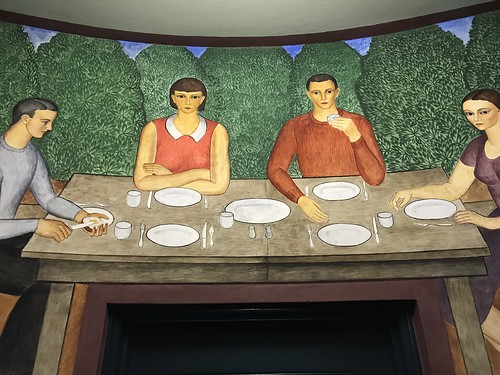
From there the hallway wraps around in a semi-circle, with murals on either side depicting outdoor leisure activities: hunting, picnicking, and relaxing in the sun around a creek. One man even has a large film camera with him.

In the last room on the second floor there’s a much more abstract mural depicting a wealthy home, perhaps preparing a dinner party. This is the only painting that’s not a fresco, instead opting for tempera paint. The bright orange background color looks like a sunset, almost glowing.
This last mural also completes the transition on the second floor, depicting an increasingly wealthy life with disposable income. This family clearly doesn’t need to pick oranges at an orchard or work in a factory to make ends meet.
The second floor murals left me with a nagging question: who was supposed to see these murals? Unlike the first floor, Coit Tower’s second floor is so narrow there’s not much room for people to move around. Today it’s limited to about six people at a time.
As far as I’m aware the space has largely been used as an access to a back room for administrative purposes over the years, yet if it was intended to be opened to the masses the hallways are too narrow for murals. And if it wasn’t intended for the public, why have murals at all?
The guide did not have any answer to this one. If I had to hazard a guess, I’d bet the unused balcony over the entrance to the tower — accessible by the second floor — was originally intended for some sort of public use. Like the rest of the second floor, this balcony is not used much today either. It all raises more questions than answers.




